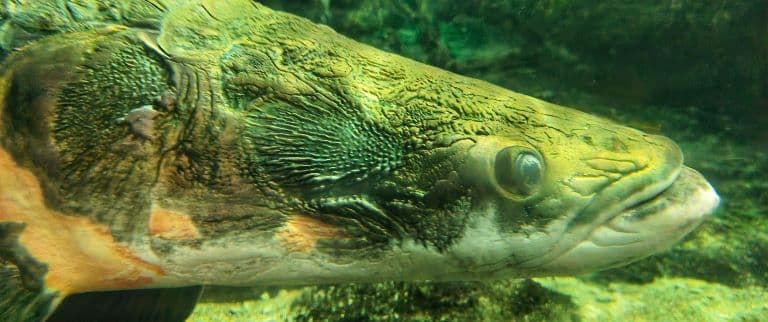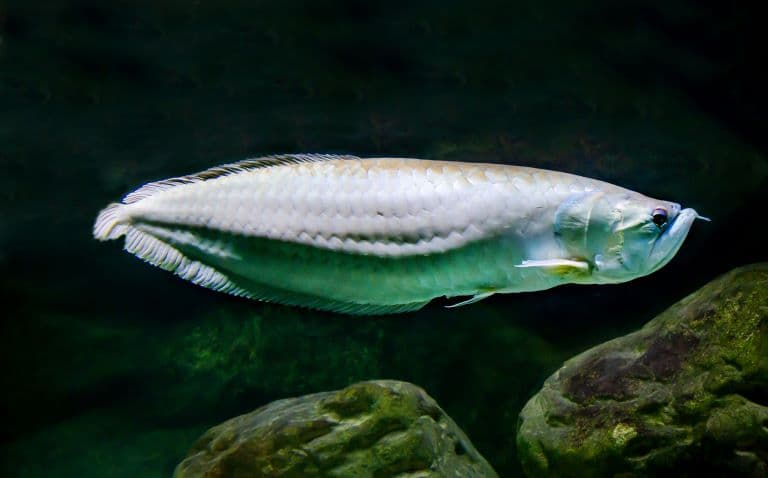Arapaima Profile
Before the Amazon rainforest became known for cheap cow feed and rampant deforestation, it was infamous for hiding innumerable secrets.
Lost civilisations, overgrown pyramids and jungle monsters found nowhere else on the planet.
To this day, the forest still releases 20 billion tonnes of water into the air every day, stores up to 200 billion tonnes of carbon and contains some of the highest concentrations of undescribed species estimated to be found on Earth.
But even among the known species, there be monsters.
And the Arapaima is one that is well-known among local peoples.

Arapaima Facts Overview
| Habitat: | Freshwater systems |
| Location: | Amazon and Essequibo basins |
| Lifespan: | 20 years in captivity |
| Size: | Up to 3.07 m (10 ft 1 in) |
| Weight: | More than 140 kg (220 lb) |
| Colour: | Blackish-green with red flecks |
| Diet: | Fish, crustaceans, fruits, seeds, insects, even land animals |
| Predators: | Humans, jaguars, caimans |
| Top Speed: | |
| No. of Species: | 5 |
| Conservation Status: | Data Deficient (IUCN) |
The Arapaima are several species of colossal freshwater fish from South America. They’ve likely been around, almost unchanged, since before the dinosaur extinction, and could have grown to even larger proportions than we know of today.
They’re not fussy eaters and will even take animals from the river banks. Some say they’re prone to attacking human boats and drowning fishermen, but by all accounts, the fish come off worse in the majority of interactions.
They’re made into steaks, nail files and handbags, and have been fished to depletion in some locations.
Thankfully, the provision of designated fishing areas has seen massive increases in their populations.
Interesting Arapaima Facts
1. They’re ancient
Some 13-million-year-old fossils of this fish have been found from Miocene deposits in Colombia (Since the Miocene dates back as far as 23 million years, this has led to erroneous claims that the fossils themselves are this old).
This interesting discovery has led to some publications calling it a ‘dinosaur fish’, which is a pretty dumb nickname, considering the dinosaurs they’re referring to went extinct more than twice as long prior to the death of these fossil fishes, but the Miocene is around the time horses and camels were invented and calling it a horse fish wouldn’t have the same ring to it.
And besides, this is exactly the kind of nerdy pedantry that makes animal bloggers lonely and unpopular.
Still, there are other clues to the origin of this fish genus – fossils of similar genera that do come from within the dinosaur reign. From these, it’s inferred that Arapaima may have originated around 110 million years ago.
This would make the Arapaima one of the oldest freshwater fishes still around today, and they have some odd characteristics that make them seem particularly prehistoric. 1

2. They can breathe air
Like other prehistoric river giants, the arapaima has a labyrinth organ. This is essentially a swim bladder that is highly vascular and can exchange gases with the surrounding air when the fish sticks its head out of the water.
This means it can breathe, and studies suggest the swim bladder has a respiratory surface almost 3 times the area of the gills and diffuses gases 88 times as well, at least in the juveniles studied. 2
3. They’re armoured
Another Lost World characteristic is the scales of this fish. They are covered in heavily mineralised plates that act as armour against bitey things like piranhas.
They are layered like plywood, or perhaps more appropriately, Kevlar: arranged at right angles, and providing massive protection against piercing forces.
These scales are also surprisingly flexible, which allows this massive beast to engage in behaviours that it has no business doing, leading American scientists to do what Americans love to do: figure out how to turn it into military equipment. 3
4. They’re a bit frightening
These fish aren’t just ancient, they’re enormous. The arapaima is one of the largest freshwater fishes in the world with confirmed lengths of over three metres and weights of more than 140 kg.
It’s usually not worth wasting the word count on “unconfirmed reports” – especially with fish – but considering this fish’s popularity and significance as a food source, it’s sensible to assume they once grew a lot larger.
So, unconfirmed reports of individuals reaching 4.6 metres and 200 kg in weight suggest that some of the legends around this river monster might be true.
And the frightening part is that they will eat pretty much anything. While they mostly pick the low-hanging fruits of fish and crustaceans, they’re said to be able to tackle terrestrial mammals that get too close to the water’s edge.
Unsurprisingly, this sort of power has led to a bit of a reputation. 4

5. They’re legendary
At least one such legend talks of a fish that’s larger than a man, who can leap from the water and knock people off their boats, crushing them with a tongue of bone.
This reference to the tongue is likely a key identifier, as this fish is a member of the Osteoglossidae, or “bone-tongue” family, and the Arapaima tongue is one of the many features that make this fish a popular catch.
Even in areas where it has become invasive, it’s developed a reputation as a killer fish, and the so-called “dragon fish” has been blamed by local fishermen for the drowning of 17 men in Malaysia.
6. They make handbags
The dried, bony tongue of the Arapaima is used as a local de-worming medicine, and its scales are rough enough to be used as nail files. It’s said to make excellent steaks and its skin has even made its way into designer handbags in the form of leather.
7. They might be in trouble
All this negative attention isn’t serving the fish well, and it’s thought to be overfished and even locally extinct in many locations within its range.
Unfortunately, the populations as a whole are not well enough understood for a formal ranking by the IUCN, and all species are listed as Data Deficient.
Local authorities have been paying some attention, and fishing of the arapaima was banned in Brazil in the ‘90s, though enforcement was so lacking it didn’t help much.
However, providing dedicated spaces for commercial and subsistence fishing of the animal has shown to be very successful, and this win-win approach for conservationists and fishermen has resulted in a huge increase of arapaima in the studied locations from 2,500 in 1999 to over 170,000 when reassessed in 2017.

Arapaima Fact-File Summary
Scientific Classification
| Kingdom: | Animalia |
| Phylum: | Chordata |
| Class: | Actinopterygii |
| Order: | Osteoglossiformes |
| Family: | Osteoglossidae |
| Genus: | Arapaima |
Fact Sources & References
- John G. Lundberg (1992), “A Miocene Fossil of the Amazonian Fish Arapaima (Teleostei, Arapaimidae) from the Magdalena River Region of Colombia–Biogeographic and Evolutionary Implications”, JSTOR.
- Marisa Narciso Fernandes (2012), “Morphometric partitioning of the respiratory surface area and diffusion capacity of the gills and swim bladder in juvenile Amazonian air-breathing fish, Arapaima gigas”, Science Direct.
- Ben Coxworth (2012), “Fish’s piranha-proof scales could lead to tough, flexible body armor”, New Atlas.
- “Dinosaur Fish Of The Amazon: The Arapaima”, Rainforest Cruises.
